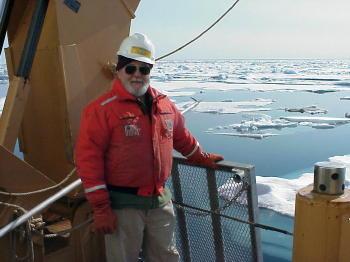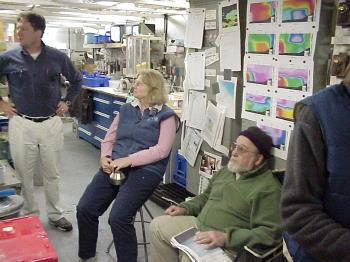
|
|
29 July, 2002
Today has been an eventful day for me as I have talked
with each member of the science service team. What an
interesting group of people! Before I tell you a
little bit about each of them and their work, let me
tell you about two other exciting things that
happened. One was on a rather large scale as someone
noticed that the ice flow that the service team was
trying to direct away from the CTD contained huge
polar bear tracks! You could actually track the
bearís movements from one end of the ice to the other.
I'll try to post the picture, but I think you'll have
to work hard to see the tracks when itís that small.
The other exciting biological event took place on a
different scale. Do you remember Carin's work with
grazing and egg production rates of copepods? Today,
as she was observing one on her screen, it began
laying eggs!! Everyone in the lab, even the chemists,
watched as she produced a cluster of misshapen eggs.
After a short period of time, the eggs will become
round and, in about eight days, they will hatch.
I've already told you about Lou Codispoti (the journal
for the 29th will be fixed soon), the science service
team leader. Now let me tell you about the other
members of this eight person team. Kristin Sanborn is
a supervisor at the Oceanographic Data Facility of the
Scripps Institution of Oceanography in California, and
she is in charge of the service team on this cruise
from midnight to noon each day. Her team at the
Oceanographic Data Facility does electronics,
chemistry, and deep ocean CTD processing using WOCE
(World Ocean Circulation Experiment) standards for
accuracy and precision of data. Members of her team
are available to go wherever there is ocean research
going on. On this cruise, Kristin is primarily
responsible for processing the data from the CTD
casts. As a result, she spends most of her time at
her computer.
Carny Cheng is also working with the group from
Scripps although he is currently an undergraduate
student majoring in computer engineering at the
University of California, San Diego. His job on this
cruise is to prepare the CTD and to sample and analyze
the CTD water for dissolved oxygen.
Another member of the Scripps team that is here is
Doug Masten. When not working on a cruise, Doug is
the manager of the chemistry lab at the Oceanographic
Data Facility. Every time a service cast comes up,
Doug collects water from every bottle (different
depths) for nutrient analysis (phosphate, silicate,
nitrate, ammonium, urea, and nitrite). This is
important because, as Doug said, the nutrients in the
water are like fertilizer in your garden, and the
scientists want to know whatís available at different
depths and at different stations. Dougís work takes
him out on three ñ four cruises each year; he is
sometimes gone for six months during the year. In
addition, he told me it might take up to two months
just to prepare for a cruise.
The final member of the Scripps team on our cruise is
Rob Palomares, the CTD/bottle rosette technician on
board. Rob is responsible for, as he puts it, the
"care and feeding of the rosette." Any maintenance
that must be done, whether it be the bottles, the
computer, or the rosette itself, Rob will work on it.
He also draws samples to run through the salinometer
to analyze for salt in the water. At Scripps, he is a
senior electronics technician.
Dean Stockwell who is on the research faculty of the
University of Alaska, Fairbanks, is the phytoplankton
man on board. He does a chlorophyll analysis from
each shallow CTD cast and from each productivity cast,
His work gives us an idea of how the phytoplankton
are distributed throughout the water column (different
depths). Remember that the phytoplankton are the
producers of the oceans. They use sunlight to turn the
carbon of CO2 into a form that animals can use. They
are obviously a critical part of the carbon cycle!
Another piece of Deanís work is looking at diatoms (a
type of phytoplankton) in the sediments (muds at the
bottom). He can separate the chlorophyll from living
phytoplankton from the chlorophyll that comes from
dead phytoplankton (phaeochlorophyll) to get an idea
of how many phytoplankton die and fall to the bottom.
He can also use this analysis to get an idea of the
geological history of the sediments.
Emily Cooper, like Carny, is on her first trip above
the Arctic Circle.. She is a faculty research
assistant at the University of Maryland. She does the
same work that Doug Masten does (nutrient analysis
with the auto analyzer) although she does it on a
different shift. She was a biology major with a
concentration in environmental science as an
undergraduate.
John Gunn monitors the ADCP, the Acoustic Doppler
Current Profiler, and also helps with the CTD. There
are two transducers on the bottom of the ship that
send pings into the water at the rate of 1/second. A
computer program has been set up to listen for the
return echoes and to measure all the components of
velocity in order to calculate the speed of the
currents beneath the ship. Johnís job is to monitor
the equipment, do the final corrections for the turns
made by the ship, and arrive at a corrected velocity.
John is a physical oceanographer who works for the
Earth and Space Research Facility in Seattle,
Washington.
This is a highly skilled and extremely important group
of people! They work around the clock to provide the
most current data possible to the scientists who are
conducting their individual research.

Dr. Lou Codispoti heads up the science service team on board. His organizational skill keeps everything running smoothly and his quick sense of humor delights us all.

These ae the "Big Three" who make the science happen on this cruise. Dr. Lee Cooper, first on the left, is co-chief scientist with Dr. Jackie Grebmeier, sitting in the middle. Dr. Lou Codispoti is sitting under a few of the data tables his service team generates on a regular basis.
Contact the TEA in the field at
.
If you cannot connect through your browser, copy the
TEA's e-mail address in the "To:" line of
your favorite e-mail package.
|
